Are there plants in your garden which you have an uneasy relationship with? For me, parsley is one such plant. My experience with parsley over the years has been generally a good one: I've grown countless healthy crops of parsley, chopped up oodles of the stuff and tossed handfuls into soups, casseroles, salads and sauces ... but ... growing it has always been full of false starts and generally fussing over the things until they're totally happy.
I find parsley can be a hard herb to get growing, and yet I know of gardeners who complain that their parsley is a weed at their place, it self-seeds like crazy, they never have to plant any, it just pops up ... and what's my problem?
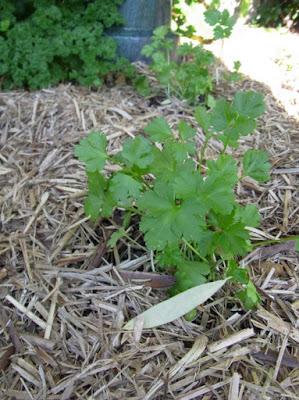
Maybe it's because my garden is overcrowded and small and turnover of plants is high, but I've rarely had self-seeding parsley cropping up of its own volition. I've tried letting plants fully go to seed, but it's never produced much in the way of results.
Instead, it's a regular ritual to replace and replant my parsley crops. Pictured above is what I planted last weekend — some small seedlings of parsley. The former parsley plants in the same spot suddenly went to seed, so I pulled them up and filled the gap with seedlings this time round.
This is not the ideal way to grow parsley, as parsley grows best from seed, but it can be grown from seedlings, if you are very very good about keeping the seedlings well watered and happy.
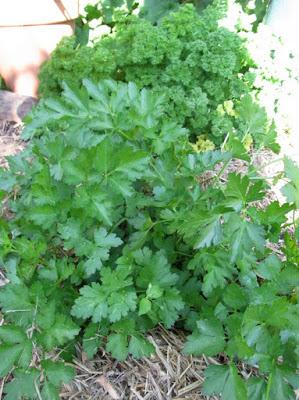
By contrast, and nearby to my bought seedlings, these two happy parsley plants (one flat-leaf and the other curly-leaf) have grown from seed sown a few months ago in late autumn. They barely needed any care at all and are powering along now.

The problem with parsley seed, pictured above, is that when you sow it, it can take three to four weeks just to sprout. It is super-slow to get going.
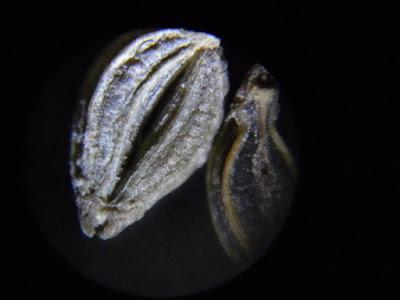
How's this for backyard science? I once put some parsley seed under my school kids' microscope (an inspired gift from Pammy) and this photo shows what a tough, ridged thing a parsley seed is. You can help to speed up germination of seed by soaking it in water overnight, but it doesn't speed things up all that much. It still takes three weeks.
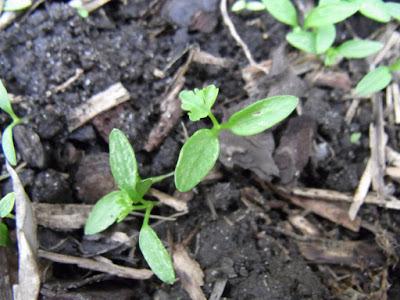
Half the trick with parsley seed is distinguishing them from weed seeds. You need to wait till the second pairs of leaves appear, and they have the distinctly parsley shape. The first baby pairs of leaves look nothing like parsley.
And the other trick with parsley seed is to simply sow lots of it. Don't worry about neatly planting one here, another there. Just scatter them in small batches, and water well, so the seed slips into cracks in the soil. Keep the area lightly moist for the next month (!) and eventually a goodly number of seeds will come up, and the baby plants that manage to grow on will usually be tough, robust and healthy.
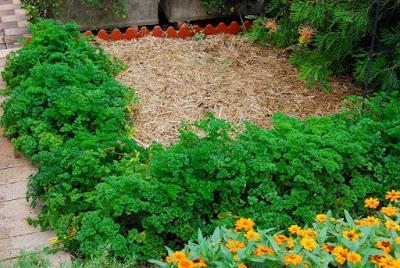
A few years ago I sowed a whole packet of curly parsley seeds to form a border around a potager vegie bed. It took months to get the whole thing going, and it was the typical mad labor of love that I like to do sometimes. But it did look nice and every plant was wonderfully healthy and quite gorgeous.
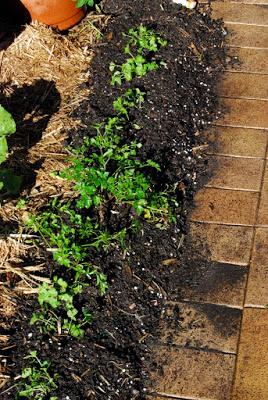
That said, growing parsley from seed takes time and patience, so it's much easier to buy either a punnet of established seedlings, or a large pot of parsley and divide it up into several clumps. Here's a few tips that might make the process work.
1. Don't over-handle the seedlings. I like to buy a pot or two of parsley seedlings, which might, if you counted them, contain 30 fairly tiny, delicate seedings. What I do is divide that into 3 clumps of 10 seedlings each, then plant each clump. Parsley is notorious for going into "transplant shock" (it's a problem it shares with some other members of the same Apiacaea family, such as parsnips, carrots, chervil and dill).
2. Water the seedlings well. Of course, water well at planting, but never let seedlings feel stressed by a lack of water. Depending on the weather (such a series of several warm spring days) that might mean daily watering with a light spray.
3. Mollycoddle them with seaweed solution. Here in Australia the leading brands are Seasol and Eco-Seaweed, but whatever you use, apply some liquid seaweed solution at planting time, and probably once a week for the first month of growth. This stuff isn't a plant fertiliser, but it is a "root-growth promoter" and also a plant-stress reducer, so it is very useful in keeping wobbly parsley babies on the right track.
After about a month in the ground, if your parsley babies are getting bigger and look like they're happy, they should turn into normal, healthy parsley plants. It's just that first month after planting seedlings which is tricky, where seedlings need extra care.
4. Take out insurance and scatter some seed. It might seem like overkill, but after planting parsley seedlings I also scatter a few seed in the same spot for luck. They'll take four weeks to sprout, and if all goes well with your seedlings, you'll never know what happened to those seeds. But if the transplanted seedlings don't make it, it's almost certain that the seed-raised plants will.
I think that's enough on parley for now ... may your crops thrive.
